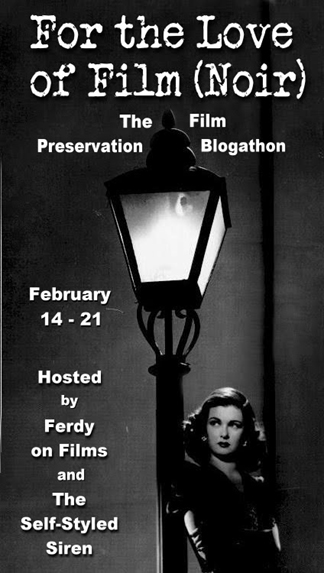
This post is my contribution to an internet event hosted by two wonderful blogs, Ferdy on Films and the Self-Styled Siren. Last year the two collaborated on their first film-preservation blogathon, For the Love of Film. This year, they are focusing in on Film Noir. This dark (in more ways than one) film genre features paranoid heroes, shady ladies, and fateful drama.
Funds donated by clicking on this link (you KNOW you need to do it!) will go to the Film Noir Foundation. Donors are eligible for prizes, but the real prize is getting to help restore the 1950 film The Sound of Fury—and to read all the great posts the blogathon is attracting.
When Ferdy and the Siren announced that they were devoting this year’s blogathon to Film Noir, I wasn’t sure whether I’d be able to come up with a film to write about. To be frank, I’m not a noir girl. As a sometime intellectual I appreciate films noirs aesthetically, but as an eternal movie fan I like to identify with characters in films, particularly female characters.
Most noir female protagonists, while interesting, are hard to identify with. They’re too busy being femmes fatales, often literally.
And then I remembered Norma Desmond, who taught me a lot about the way we relate to films—and about the aging process.
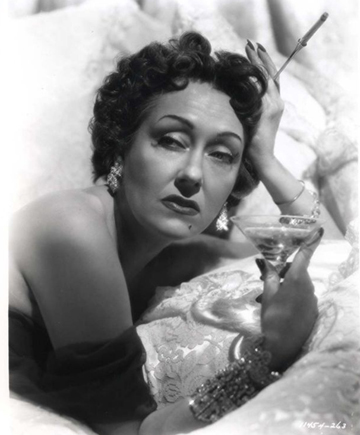
Norma Desmond is the iconic heroine (I see her as a heroine, anyway) of Billy Wilder’s 1950 film Sunset Boulevard. Played with studied camp and seemingly effortless glamour by Gloria Swanson, Norma is a relic of a recent (in 1950) but almost forgotten (also in 1950) facet of Hollywood’s history, the silent-film industry.
When sound film came along, many performers’ careers were finished. And so it was that the premise of the film–that a woman of 50 who had been an enormous star 20 years earlier was now almost forgotten–could be believable.
Wilder took advantage of that believability by casting several silent-film greats as Norma Desmond’s bridge-playing cohorts; the film’s younger, irreverent narrator, Joe Gillis (William Holden), refers to them as her “Wax Works.” Swanson herself hadn’t been in a successful film in many years, although she had kept busy on the stage.
Norma Desmond deals with her exile from stardom by denying it, by trying to live as much as possible in the past. She fastens on to Joe, an out-of-work screenwriter, as a possible vehicle for her comeback (she actually prefers the word “return”).
She hires Joe to revamp the script she hopes will re-launch her career and soon turns him into a kept man ensconced in her fading old mansion.
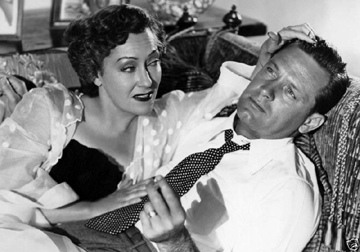
Joe grows more and more resentful, and Norma grows more and more delusional. Norma’s final murder of Joe is no surprise since it is previewed in the film’s opening shots. Nevertheless, Wilder managed to make the film’s ending sad, haunting, and more than a little scary.
When I first saw Sunset Boulevard I was about 20. I already had a major crush on William Holden and tended to see the film through his character’s eyes. To the young me Norma Desmond was a frightening old witch, and I rooted for Joe Gillis to end up with the more age-appropriate Betty Schaefer (Nancy Olson).
A reader at a studio, Betty criticizes Joe’s newest screenplay early in the film. Viewers later learn that she is harsh because she believes he has potential. The two end up collaborating on a screenplay late at night when Norma is asleep. Betty says she wants to work on the screenplay because she is ambitious, but she doesn’t want to work on it without Joe, with whom she is obviously smitten.
She is presented as the anti-Norma, young and interested in promoting Joe (a traditional feminine attitude) rather than herself. She allows herself to be kissed by Joe rather than reaching out to grab him as Norma does.
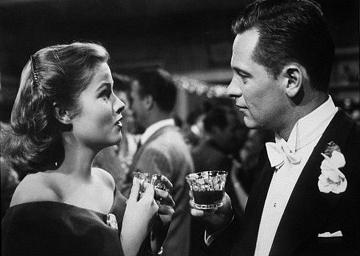
Norma says she is in love with Joe, but she wants him to bolster her ego and her career; his career is of secondary interest to her (if it is of interest at all).
When the young me watched Sunset Boulevard, she asked all the “what if” questions about Joe that the film encourages: what if Joe had gotten away from Norma; what if he had become a good, honest screenwriter; and so forth.
I saw Sunset Boulevard again in a film class when I was in my early 30s, as part of a discussion of classical Hollywood narrative. I found myself crying at the picture’s end.
I wasn’t crying for poor dead Joe, however. I was crying for poor live Norma. And I cry for her now each time I see the film.
I admit that the character has major flaws. She is vain, selfish, prone to emotional blackmail, and ultimately insane. Nevertheless, as another memorable Billy Wilder character later said, “Nobody’s perfect.”
Betty’s major appeal is that she is 22 years old. Anybody can be 22—or at least, just about everybody is 22 at some time or other.
Norma is hardworking, talented (she is luminescent in the scenes from her silent-film work projected in her living room, real footage of Swanson in the unfinished film Queen Kelly), and barely middle aged.
The scene in which she sails in to the Paramount Pictures lot to confer with her former director, Cecil B. DeMille, is touching. She meets several of the “little people” with whom she used to work—a security guard, an electrician, a hairdresser—and one gets a sense of what the young Norma Desmond might have been like.
DeMille’s character describes her as “a plucky little girl of seventeen, with more courage and wit and heart than ever came together in one youngster.”
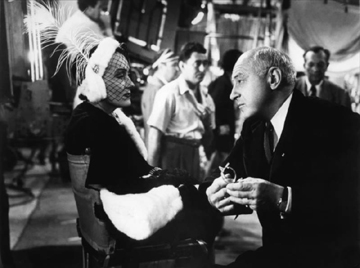
The older Norma may have lost some of her wit(s). She still has a lot of courage, if not quite enough to face what has become of her stardom and her audience. And she exhibits all too much heart.
It’s a tribute to the power of film—to the power of a good film, anyway—that I can relate to different characters and different storylines at different ages.
Perhaps when I’m 65 or so I’ll identify with Max von Mayerling, Norma’s butler, who is also her ex-husband and former film impresario. In a sense Max is the most selfless person in the film, since he lives only to give Norma Desmond what she wants.
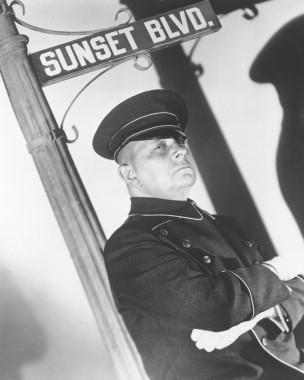
Or maybe I won’t identify with him. I’ve never been completely selfless.
Moreover, it’s hard not to remember that Max is played by Eric von Stroheim, whose reputation went a little overboard in the NON-selfless direction.
According to Billy Wilder, this egotistical, autocratic former film director threatened to sue the Academy of Motion Picture Arts and Sciences for nominating him as best supporting actor in Sunset Boulevard because he COULD NEVER BE a supporting player. (Wilder may have made the story up, but it’s plausible.)
We’ll see how the film strikes me when I hit 65.
In any case, I urge readers to watch the film again (or for the first time) and tell me whom they identify with.
On to a recipe……
I thought long and hard about recipe choice for this post. I might have selected something organic and vegetarian; Gloria Swanson was a noted health-food enthusiast and an early proponent of local, organic foods.
I almost made the biscuits in this 1933 recipe (if you can call it that;it’s just cheese added to biscuits), which a Bisquick recipe booklet claimed was a Swanson favorite.
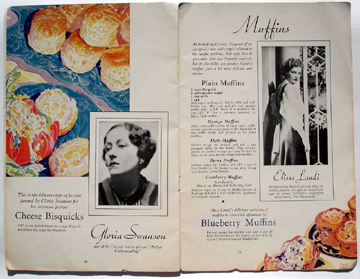
In the end I decided to honor Film Noir as a whole with a Valentine’s Day adaptation of the classic Icebox Cake. One if the visual signatures of many films noirs is a series of bars across the screen (often across actors’ faces) that symbolize the shadows that hover over the doomed characters, and the prisons that many film-noir protagonists create for themselves.
Adapted from Nabisco
Ingredients:
2 cups heavy cream
1 teaspoon vanilla
several tablespoons framboise or Chambord (raspberry liqueur)
1/2 pint raspberries (more if you like and can afford them!)
1 package (9 ounces) Nabisco Famous Chocolate Wafers (these flat, round chocolate cookies are difficult but not impossible to find; just ask around at area grocery stores)
Instructions:
Whip the cream until stiff peaks form. Fold in the vanilla and liqueur.
Gently crush 2/3 of the raspberries and fold them carefully into 1/2 of the flavored whipped cream. Reserve the remaining whipped cream.
Spread about 1-1/2 tablespoons of the raspberry/cream mixture onto a wafer. Top it with another wafer. Stack them standing up until you have 9 or 10 wafers; then gently lay the stack on its side on a serving plate. Repeat, adding to the horizontal stack, until you have used up the remaining wafers.
Cover the log of stacks with the remaining whipped cream.
Refrigerate, gently covered, for at least 4 hours.
Remove from the fridge just before serving and garnish the torte with the remaining raspberries. Slice diagonally so that black-and-white bars appear.
Nabisco’s original recipe says its cake serves 14; in my family, it served 8 to 10.
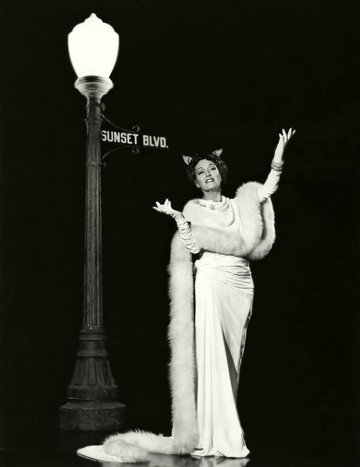
Tags: film noir, identification with film characters, Norma Desmond, raspberry icebox cake, Sunset Boulevard
This entry was posted on Monday, February 14th, 2011 at 4:00 am and is filed under Cakes, Pies, and Pastry, TV and Film History. You can follow any responses to this entry through the RSS 2.0 feed.
Both comments and pings are currently closed.







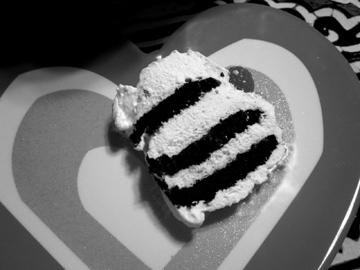

What a terrific post this morning, Tinky! And how – in a film-noirish sort of way – appropriate for Valentine’s Day. If there’s time, maybe we’ll watch Sunset Boulevard this evening on Netflix, but it’s unlikely that we’ll replicate the icebox cake you offered (brilliant choice, great black-and-white illustration) as the perfect culinary graphic to pay homage to the signature diagonal shadows that fell across film noir screens. Once again you’ve proven that your blog is a rich pantry of ideas and ingredients! The entire post looked spectacular. Thank you.
Great blog, Tinky. And the recipe is JUST RIGHT for your theme. Nice job. I guess it’s time for your close-up.
This is one of those desserts I grew up with. It kept company with Junket (remember that one?). A real 60’s 70″s convenience thing that hales from the marketing desk of the likes of Mad Men.
The thing about this dessert is that it is really yummy! But, I have made an even more fantastic variation on it by using those flower shaped thins by Anna. They come in ginger, lemon, chocolate and orange. You can make the same traditional log cake that you describe above, Tinky or simply fill two waffers with the whipped cream (and let them sit for a couple of hours before eating, the same as with the cake). I love using one chocolate and one orange, or all ginger or using one orange and one lemon. The little scalloped edges of the cookies look so pretty too and make this a wonderful quick and easy party platter offering! Yumminess, -janice
Tinky – What a great post. I love Sunset Boulevard and agree with the reaction you have to Norma. She may be a crazy relic and a killer, but boy does she have style. It’s so great to see a woman on screen who is absolutely certain of her worth and resentful that she has been cast aside because she is no longer young – though, in fact, she is still very attractive.
Thanks for supporting the blogathon. And the recipe sounds yummy!
[…] Weisblat has a wonderful tribute to Norma Desmond in her entry on Sunset Boulevard at In Our Grandmothers’ Kitchens. Not to mention a killer recipe for icebox […]
Great post Tinky on a film I absolutely adore (and was hoping to write about later this week, but you’ve done so well….).
A note on the cheese bisquicks, I will bet at this time Swanson would not have been eating them. She became an early vegan (I can’t remember the name of the doctor) but after an illness she gave up processed foods, white sugar, etc. Certainly did her no harm, she looked remarkable with skin that a 22 year old Betty Schaffer would have been envious of.
Tinky, you’ve outdone yourself! I wasn’t going to read the whole thing this morning, but once into a line or two I HAD to finish, and I’m so glad I did. I don’t think I’ve ever seen Sunset Boulevard, even though I went through a William Holden phase myself (Picnic…..swoon!).
The recipe you’ve chosen is absolutely perfect. Altogether a smashing entry in your blog today~congratulations!
Tinky,
What a wonderful post! As it happens I saw the film a few months ago, and maybe I am getting on in years, but I found Max a most endearing character. I agree with you about Norma: she shows that she cares about the people she knew, even though she is using everyone to make her comeback, and I couldn’t abide Joe– he just seemed so thick.
Max, on the other hand, grew on me throughout the film so while in the beginning I was suspicious of him, by the time it was clear who he was, he became most sympathetic.
A great tribute to a great genre, and a fine looking recipe, too. Now you need to expand your noir dessert repertoire:
Key Largo Pie
This Ganache for Hire
The Maltese Frosting
Flaneur and Jack, bless you both; it was a fun post, as you can probably tell. Janice, I will DEFINITELY try your torte. Marilyn, it’s true: style makes up for a lot. Donna, I hope I get to read your take on the film–and I’m sure you’re right about the biscuits! Jean, swoon indeed; I was so sad when he died so needlessly because he had so much going for him. David, what a great take on Max; it’s true, he does seem very strange at first. And, Peter, I think this is the beginning of a beautiful friendship, to quote a film that isn’t really noir. We’ll have to think of more desserts!
Delicious (in every way.)
I think what you’re responding to in Norma is her Tragic Grandeur. Betty’s a nice girl — smart and decisive. But she lacks the epic quality that comes so easily to Norma. That’s why Norma isn’t a sad old woman who time has passed by. She’s a towering figure on par with Wagner’s demi-gods in the “Ring” cycle. And like them she faces a terrible fall.
Well put, David. Norma is indeed a classic tragic figure.
Wondermous post, Tinky – I like the dessert! This film is much fun to watch, thanks for making me think about it as I’ve crept up in years.
Tinky, I enjoyed reading this post! I love how you personally connected with the film. I feel for Norma the most, too.
Your recipe looks fabulous! I’ll have to save it, but right now I’m going to give into my sweet tooth you stirred and eat a messy chocolate cupcake.
Vanwall, I’m sure you have lots of creeping left to do. And Beth Ann, the cupcake sounds divine………
agreed with all that this is perfect! I would also agree (in my early 20s, no less!) that norma is a character you root for in a weird way. it’s rooting for all the swansons and the davis’ whose careers dried up as they aged when the talent didn’t.
and I did not know that tidbit about von stroheim but somehow am not surprised. 😉
-Meredith
Meredith, you are obviously wiser in your 20s than I was in mine!
I wonder if Gloria Swanson actually used Bisquick? How horribly un-glamorous! I’m going to have to try the icebox cake; I’ve never made one before.
I think Donna is probably right, Lauren, that even in the 1930s she wouldn’t have touched it. But I hope you DO try the icebox cake!
Tinky: I like your thoughts on how your reaction to the movie has changed over time. I think that’s a mark of a great work of art. Gloria Swanson made Norma a real person with her great talent, but many people wound up thinking Norma was Gloria.
The cake is a great connection with film noir. I like your appropriate black and white photo.
Thanks, Joe. Alas, my photography was B&W only courtesy of Photoshop; I have no idea how to take one these days. But I thought it was a nice touch, too.
Excellent post! I also remember a less memorable but still pretty good “Twilight Zone” show starring Ida Lupino as a Nora Desmond-ish character.
I am a definite Lupino fan, Paul, so I’ll have to seek that one out! Thanks for visiting……
Tinky: Ida Lupino was both starred in a Twilight Zone episode and directed one (“The Masks”, a wonderfully dark tale of New Orleans and “all in the family” skullduggery in a family).
I did manage to crank out one more short posting – my recipe for film noir – for the blogathon. http://psychotronicpaul.blogspot.com/2011/02/last-day-of-film-preservation-blogathon.html.
Pardon my redundancy. I meant “all in the family” chicanery and skullduggery!
I’m redundant A LOT, Paul. I’ll have to look for multiple Lupino episodes. Thanks! And I enjoyed your recipe…
Ida Lupino directed nine episodes of Thriller!
Paul, I’ll definitely have to look for Thriller. I consider myself a Classic TV girl, but I have never seen it. Sigh…